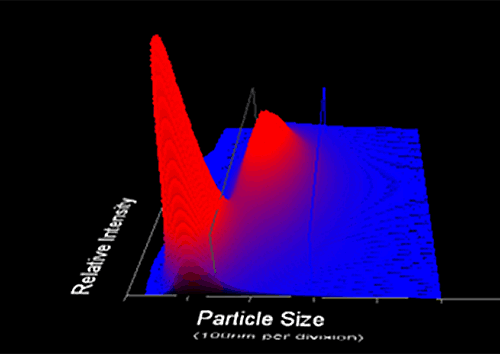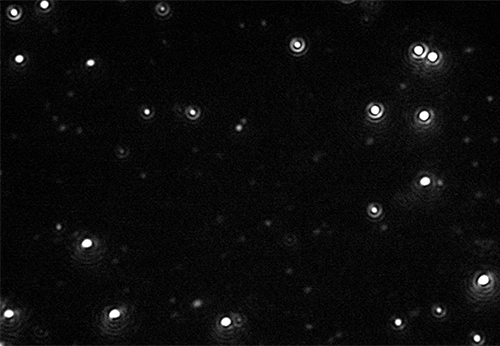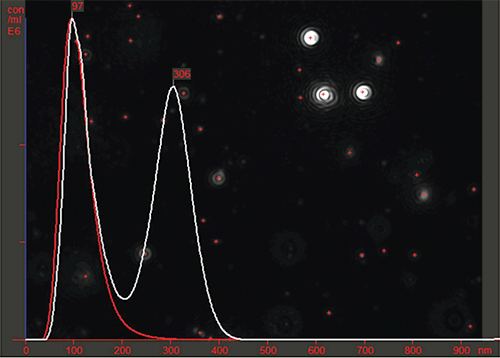The titer of bacteriophage and virus particles is established by plaque assay or, in the case of animal cell viruses, by a cell-based bioassay. In these array systems, infective virus particles are grown in confluent cell layers to produce plaques (zones of destroyed cells) which can be counted to determine the number of plaque forming units (pfu). While this gives a direct count of individual infective virus particles, non-infective virus particles do not produce plaques, and aggregates containing many virus particles will produce only single plaques. Often, the manufacturer needs to know the number of virus particles in the preparation, whether infective or not, and the degree, if any, to which the preparation is undergoing aggregation as an early indicator of limited shelf life.
Nanoparticle Tracking Analysis (NTA) allows nanoscale particles such as viruses and virus aggregates to be directly and individually visualized in liquids in real-time, from which high resolution particle size distribution profiles can be obtained. The technique is fast, robust, accurate and low cost, representing an attractive complement to existing methods of nanoparticle analysis such as Dynamic Light Scattering (DLS), Photon Correlation Spectroscopy (PCS) or Electron Microscopy (EM).
The NanoSight range from Malvern Instruments uses NTA to analyze particles in liquids from 10 nm - 2000 nm in diameter. NTA utilizes the properties of both light scattering and Brownian motion in order to obtain the size distribution of particles in liquid suspension. A laser beam is passed through the sample chamber and the particles in suspension in the path of this beam scatter light in such a manner that they can be easily visualized. The Stokes-Einstein equation is then used to calculate the size of each individual particle. Results are displayed as graphs of size against concentration of individual particles (or size vs. relative brightness).

|
Viral vaccine preparations must be proven (validated) to be stable and to contain known proportions of active elements. NTA allows an immediate and direct estimation of product purity and concentration. Similarly, the degree and rate of the formation of aggregates in a virus preparation can be measured using NTA, allowing the manufacturer to develop improved product manufacturing processes and to optimize product shelf life.
As NTA allows all particles in the preparation to be visualized and sized, additional information about nanoparticle content is made available in a shorter time than would be available through conventional TCID50 or plaque assays. For instance, the presence of larger particles (for which NTA can measure both size and concentration) could represent either non-viral cell debris from the cell culture process or aggregates of virus particles containing many individual virions.
In either case, such aggregates/contaminants represent a possible problem to the manufacturer, one which can be immediately identified with a Malvern NanoSight system.

|
Virus clearance effectiveness is assayed by spiking samples with carefully prepared high titer virus samples (of various types depending on application). These are then used to challenge process steps which need to be qualified as a clearance step. The data must be obtained with pure, non-aggregated virus spike material which must first be prepared at high titer and stored before use. NTA is ideally placed to establish the status of aggregation both before and after storage.
The ability of the Malvern NanoSight instrument range to rapidly establish the degree to which a virus preparation contains contaminants or aggregates and to be able to quantify the levels of such has proved invaluable to process developers interested in optimizing purification protocols for virus preparation. For example, Figure 3 shows the difference between a partially purified virus preparation (white line) and the same sample having been successfully passed through an efficient purification protocol which effectively removed all contamination or aggregated material (red line). Note that the vertical axis represents particle concentration (virus particles/mL).

|
Virus particle detection and counting using NTA is providing essential information for researchers at the University of Strathclyde’s Institute of Pharmacy and Biomedical Sciences (IPBS). This team develops methods to employ naturally occurring bacteria to combat MRSA. MRSA (or Methicillin Resistant Staphylococcus aureus) is a variation of the bacterium Staphylococcus aureus which has developed resistance to most antibiotics, making it difficult to treat and potentially deadly. Whilst the “Superbug” can be killed with detergents, detergent dilution and application is often inconsistent and ineffective, making the bacteriophage therapy route an attractive alternative. Bacteriophage therapy involves the use of bacteriophages to destroy their host bacteria by replicating within and then lysing the host cells.
It is in characterizing bacteriophage cultures that NTA is employed within a team led by Dr. Mike Mattey, honorary lecturer at IPBS. Prior to deploying bacteriophages as a dry-coat to protect high-risk bacterial invasion sites (sutures, instruments and wounds), the cultures need characterization and their concentration needs assessing. NTA allows the team to view and size viral cultures rapidly in real-time and at low cost. “The characterization of virus populations requires assessment of aggregation in the 20 nm – 1000 nm range” says Dr. Mattey. “NanoSight provides fast and easy quantitative sample characterizations. Additionally, NanoSight’s technology provides a reassuring view of the particle population that supports the counting results.”
A wide range of virus types have been successfully analyzed to date and include:
(Carr, B. (2009) Nanoparticle tracking analysis: direct visualization for counting and characterizing virus particles in liquids, Meeting the challenge of viral pandemics, 2009 - biotech-online.com)